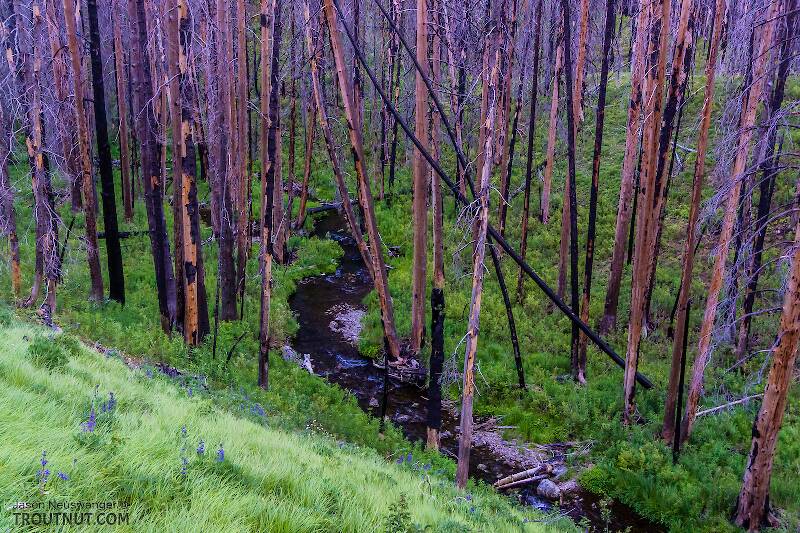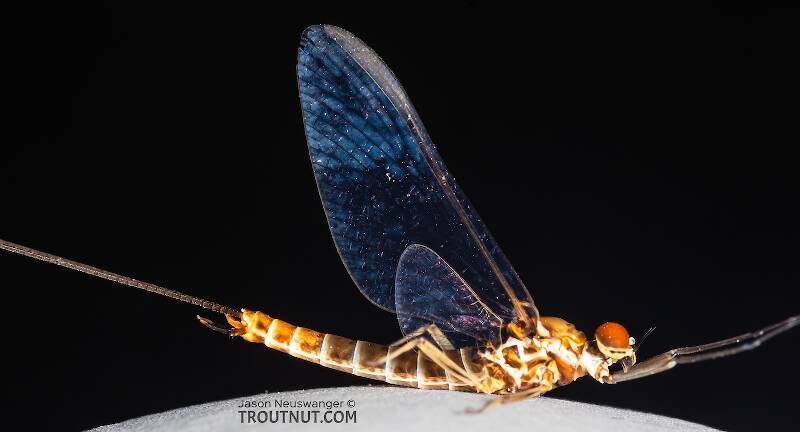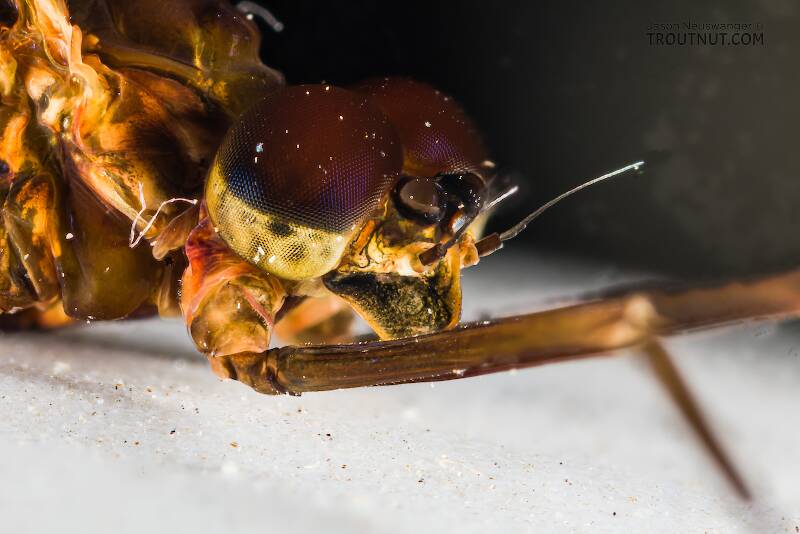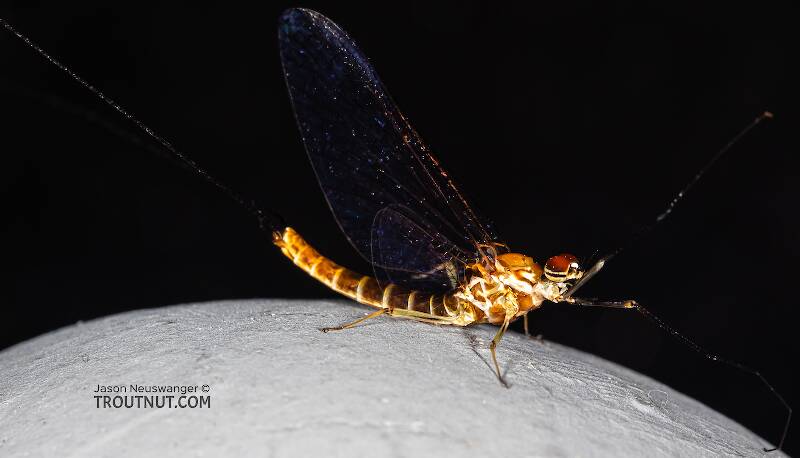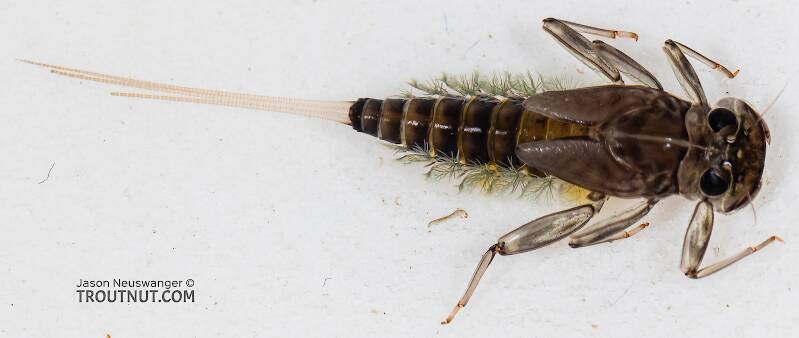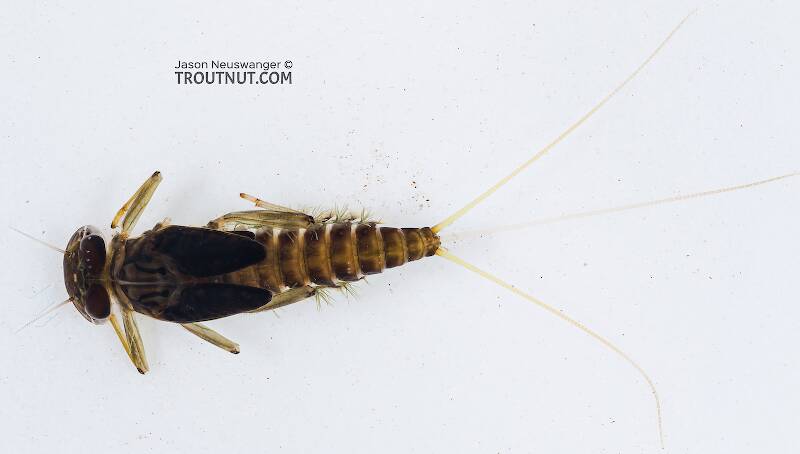
Hex Mayflies
Hexagenia limbata
The famous nocturnal Hex hatch of the Midwest (and a few other lucky locations) stirs to the surface mythically large brown trout that only touch streamers for the rest of the year.


Mayfly Species Rhithrogena hageni (Western Black Quills)
Where & when
There are conflicting accounts of the hatch dates for this species. Caucci and Nastasi list it as a July-August emerger, but Knopp and Cormier speak of it hatching in the spring. I have collected it as early as May in western Washington.In 14 records from GBIF, adults of this species have been collected during July (29%), September (21%), August (21%), June (7%), May (7%), March (7%), and April (7%).
In 13 records from GBIF, this species has been collected at elevations ranging from 3500 to 9596 ft, with an average (median) of 7543 ft.
Species Range
Spinner behavior
Time of day: Late evening to dusk
Female spinners commence their fall during the evening or just before dusk, when air temperature has fallen to the low 60s °F. If the air temperature drops below 58°F, the spinner fall is often delayed until the next morning.
Physical description
Most physical descriptions on Troutnut are direct or slightly edited quotes from the original scientific sources describing or updating the species, although there may be errors in copying them to this website. Such descriptions aren't always definitive, because species often turn out to be more variable than the original describers observed. In some cases, only a single specimen was described! However, they are useful starting points.
Male Spinner
Wing length: 11-13 mm
A species of the brunnea (now a synonym of R. hageni) group, penes distinctly outcurved at tip, with large ventral spine on inner margin.
Thoracic notum “bright brown ochreous, the peak of the mesonotum flavescent, a line adjacent to the tegulae and a streak below it and in front of these in a depression brown-black” (Eaton). Fore legs brown, tibia and tarsus blackish brown. Middle and hind legs yellowish brown, tarsi somewhat deeper brown. Femora marked in basal area "with a longitudinal brown-black streak tapering at both ends” (Eaton). Wings hyaline; fore wings very faintly tinted with light brownish grey in stigmatic area. Venation deep brown, paler at wing bases. 4 or 5 basal costal cross veins before bulla; 5 to 7 simple cross veins and 11-14 anastomosing veins are beyond bulla. Abdominal tergites pitch-brown, posterior margins darker. Sternites reddish yellow, immaculate. Tails dark brown, joinings mostly opaque. Tips of penes distinctly curved outward; a basal Iateral spine on outer margin, and a strong ventral spine on or near inner margin nearer apex. Apical spines weaker than in Rhithrogena morrisoni (See fig. 100).
A larger species than R. morrisoni, differing in detailed structure of penes as indicated. The allied species, Rhithrogena virilis, lacks the ventral median spine and possesses small sharp spine on the latero-apical edge of each division of the penes, which is not present in brunnea (now a synonym of R. hageni).
Described as R. doddsi
Body length 10 mm, wing length 11 mm
A species of the brunnea (now a synonym of R. hageni) group; penes broad at apex, almost erect.
Head deep brown; a pale band in region of antennae. Thorax brown; scutellum slightly paler; pleura mainly pale ochreous. Legs dark amber-brown. Fore tibia and tarsus smoky brown; a dark longitudinal streak on basal half of each femur, often entire femur appears shaded with black. Wings hyaline; venation fine, dark brown; basal costal cross veins obsolescent. Abdominal tergites brown; intersegmental areas paler. Sternites dull yellowish brown. Forceps and tails smoky brown. Penes almost straight, not outcurved at tip, wide apically; a ventral spine on each division, near inner margin, halfway between apex and lateral spine (see fig. 101).
Very closely allied to Rhithrogena futilis, from which it may be distinguished by the detailed structure of the penes, which are wider at tip and more erect than in that species; in futilis also, a small dorsal spine is present on each division of the penes.
The rose-red gills and small erect dorsal lobe on each of the intermediate pairs seems distinctive of the nymph of this species.
Specimens of the Mayfly Species Rhithrogena hageni
1 Female Dun
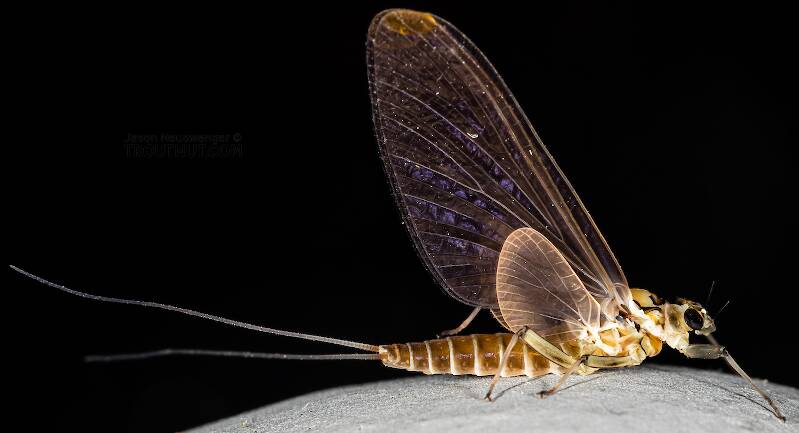
3 Male Spinners
2 Nymphs
Start a Discussion of Rhithrogena hageni
References
- Arbona, Fred Jr. 1989. Mayflies, the Angler, and the Trout. Nick Lyons Books.
- Baumann, Richard W. 1975. Revision of the Stonefly Family Nemouridae (plecoptera) : a Study Of The World Fauna At The Generic Level. Smithsonian Contributions to Zoology undef(211): 1-74.
- Caucci, Al and Nastasi, Bob. 2004. Hatches II. The Lyons Press.
- Knopp, Malcolm and Robert Cormier. 1997. Mayflies: An Angler's Study of Trout Water Ephemeroptera . The Lyons Press.
- Needham, James G., Jay R. Traver, and Yin-Chi Hsu. 1935. The Biology of Mayflies. Comstock Publishing Company, Inc.
Mayfly Species Rhithrogena hageni (Western Black Quills)
Species Range
Resources
- NatureServe
- Integrated Taxonomic Information System
- Global Biodiversity Information Facility
- Described by Eaton (1885)

